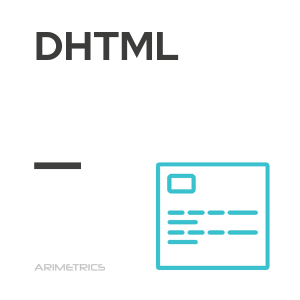 Definition:
Definition:
DHTML, or dynamic HTML, is a term that refers to the combined use of web technologies to create interactive pages that can change and respond to user actions without the need to reload the entire page. This real-time modification capability significantly improves the user experience.
What it is used for in dynamic DHTML
DHTML is essential for developing Web sites that are more attractive and functional. It allows developers to implement:
- Enhanced interactivity: Users can interact with the page in richer and more dynamic ways, which can include everything from drop-down menus to content that changes in response to user actions.
- Richer user experiences: By integrating multimedia elements and visual effects, pages become more engaging and can communicate information more effectively.
- Real-time updates: With DHTML, the content of a page can be updated automatically, as in the case of news feeds or stock quotes.
Requiring no additional plugins like Flash, DHTML uses standard technologies such as HTML, CSS, DOM, and JavaScript, making it widely compatible and accessible.
Using DHTML
DHTML offers a variety of practical applications:
- Animation of elements: Allows you to move, resize or alter text and image content without reloading the page. This is useful for creating attractive visual effects.
- Dynamic content update: Sections of the page can be automatically updated to show current information, such as weather or sports scores.
- Advanced forms: Forms can validate data in real time, providing instant feedback to the user and improving efficiency.
- Improved navigation: Interactive menus and user-responsive buttons can significantly improve site usability.
DHTML and its importance in SEO
For SEO, it is essential to implement DHTML so that search engines can access and index dynamic content. This involves:
- Content visibility: Ensure that important elements, such as text and links, are visible to search crawlers.
- AJAX Indexing: Verify that the contents loaded through AJAX are accessible to crawlers, as this may affect the page ranking.
- Load optimization: Minimize the impact of scripts and styles on page load time, which is an important factor for SEO.
Difference between DHTML and dynamic pages
It is important to distinguish between DHTML and dynamic pages. While DHTML refers to client-side changes (the interaction and display in the browser), dynamic pages are generated on the server, adapting to user requests. This means that:
- DHTML: Focuses on improving the interactivity and presentation of content in the user’s browser.
- Dynamic pages: These use server-side languages such as PHP, ASP or Ruby to generate content that can vary according to user input, such as forms or searches.
Both technologies are complementary and, when used together, can create powerful and flexible web experiences.
